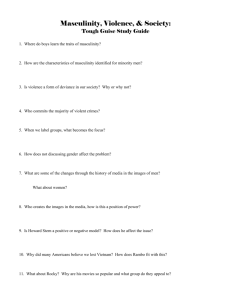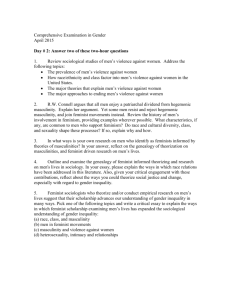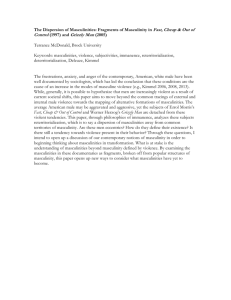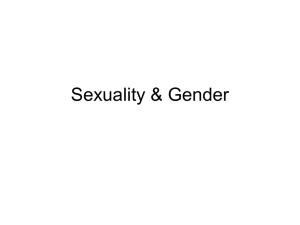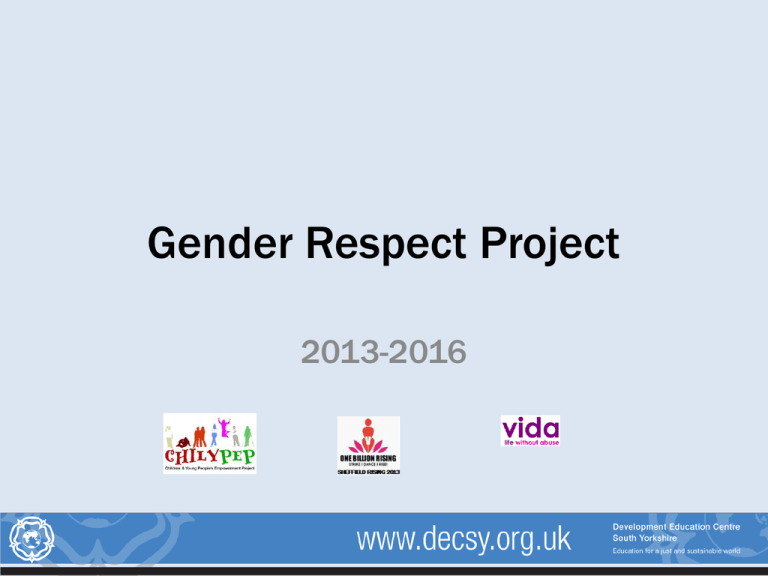
Gender Respect Project
2013-2016
The Inspiration for the Project
• One Billion Rising (onebillionrising.org)
Aims of the Project
• To help children and young people to
understand, question and challenge gender
inequality and violence in a local-global
context
Learning outcomes
Children and young people (aged 4-14) will:
• Question gender stereotyping (including exploring
masculinities and femininities, engaging boys in redefining
masculinities as well as girls; critique of social media etc)
• Understand global and historical contexts of gender relations
• Explore issues of power, justice, equality, freedom and human
rights in the context of gender
• Feel empowered to take action (this will include supporting
young people’s creative responses, including use of social
media, you tube etc and will build on positive role models
from around the world).
How we will achieve our aims
• We will bring together teachers along with
creative practitioners / artists and young
people to develop engaging, participatory
and creative curriculum activities and
materials
• These materials will be disseminated
through websites, conferences and training
Activities & time frame
April 2013
Project begins, research and recruitment of teachers /
volunteers
Sept 2013
Develop Wordpress site for ongoing dissemination
Oct 8th
Introductory meeting for teachers
18th-19th Oct 13
Teachers’ Residential (Wortley Hall)
Nov 13 – Dec 15
Half day meetings 1 x per term to develop curriculum
materials, try them out and write up. Twilight meetings as
required.
Jan-July 2016
CPD training/ INSET / conference workshops delivered to
other teachers with involvement of project teachers /
volunteers
Who’s involved?
• Steering group (including link with funder)
• Project coordinator (Helen)
• Project teacher group
(9 EYFS/Primary/Sec)
• Volunteers
• Young people (focus groups / consultation)
• Artists
• Wider network of interested teachers /
others
Research and theory on gender
1. Violence against women and girls as a
starting point
2. Gender inequality as root cause of gender
violence
3. Components of gender inequality: gender
roles, power relations, social norms
4. What does this mean for education?
The problem of violence against
women and girls globally
• Global problem with a global response e.g.
One Billion Rising
UN Convention on the Elimination of all
forms of Discrimination Against Women
(CEDAW)
• Powered by grass roots activism in
localities across the world
What do we mean by ‘violence against women &
girls’? What form does this take globally, in our
communities, in our schools?
Facts and statistics
• www.whiteribboncampaign.co.uk/videos
End Violence Against Women YouGov
Poll, Oct 2010
• 71% of 16-18-year-olds say they have heard sexual
name-calling such as ‘slut’ or ‘slag’ towards girls at
school daily or a few times per week
• Close to one in three (29%) 16-18-year-old girls say they
have experienced unwanted sexual touching at school
• Close one in three (28%) of 16-18-year-olds say they
have seen sexual pictures on mobile phones at school a
few times a month or more
(Total sample size was 788 adults. The survey was carried out online. The
figures have been weighted and are representative of all 16 to 18 year olds from
the UK on age and gender. )
NSPCC ‘Sexting Report’ 2011
• ‘One of the key findings of this research highlights the extent to
which gendered power relations saturate the young people’s lives.
No understanding of sexting would be complete without an
appreciation of the extent to which an often completely normalised
sexism constitutes the context for all relationships both
on and off-line’
• ‘deeply rooted notion that girls and young women’s bodies are
somehow the property of boys and young men’
• ‘boys failure to perform a particular kind of macho masculinity
carries with it the risk of being labelled ‘gay’: “If they had a picture of
a girl naked and you told them “That’s wrong” they will think straight
away you are gay” (Focus group, year 10 boy)
A Qualitative Study of Children, Young People and ‘Sexting’, A report prepared for
the NSPCC by Institute of Education, London King’s College, London School of
Economics, Open University
What is ‘violence against
women’?
‘any act of gender-based violence that results in,
or is likely to result in, physical, sexual or
psychological harm or suffering to women and
girls, including threats of such acts, coercion or
arbitrary deprivation of liberty, whether occurring
in public or in private life. The Commission also
notes the economic and social harm caused by
such violence’ CEDAW 2013
‘Agreed conclusions on the elimination and prevention of
all forms of violence against women and girls’
What are the roots of
gender-based violence?
• ‘the historical and structural inequality in power
relations between women and men’
• ‘intrinsically linked with gender stereotypes that
underlie and perpetuate such violence’ as well as
other factors that can increase women’s and girls’
vulnerability to such violence’ CEDAW 2013
‘Elimination and prevention of all forms of violence against women and girls’
Gender Inequality
Gender
roles
Power
relations
Social
Norms
Gender
roles
Gender Roles
Distinction between ‘sex’ and ‘gender’
• ‘Sex’ refers to the biological and
physiological characteristics that define men
and women.
• ‘Gender’ refers to the socially constructed
roles, behaviours, activities, and attributes
that a given society considers appropriate for
men and women (World Health
Organisation)
Even monkeys!
Wild Japanese macaque
monkeys (Macaca Fuscat
Fuscata)
Gibraltar - Males take care of
young
Morocco - Females take care of
young
http://www.flickr.com/photos/richardfisher/
And rats …
Tatiana Bulyonkova
http://www.flickr.com/photos/ressaure/
In pairs:
How do we learn to do gender? What is
your theory on this - how does a child learn
to be a boy or a girl?
Represent this as a picture / diagram to
show to everyone else.
For women of the Awá hunter-gatherer tribe in the Brazilian
Amazon, ..the most threatened tribe on Earth – equal
status with Awá men is normal. Some Awá women even
take several husbands, a practice known as polyandry.
The Awá are one of only two nomadic hunter-gatherer
tribes left in Brazil..
Survival International
http://www.survivalinternational.org/awa
Socialisation Theories
Socialisation theories: children develop
gender identities from messages given by
significant others and by observing and
absorbing how people around them behave
PROBLEM: assumes identity fixed and
coherent; doesn’t answer question of why
children accept some ideas and reject
others and ignores issue of ‘power’
Post-structuralist theory
• The relationship between the individual and social
institutions is seen to be inseparable,
interdependent
• Children don’t just soak up their identity from
people and institutions they reshape and develop
individual identities as they engage with the
diverse and often contradictory messages they
receive from caregivers, at home, from the media
and in preschool settings
• ‘Children actively construct meaning but not free
to construct any meanings or identities she/he
wants… limited to alternatives made available to
them
• Children do not enter a ‘free marketplace’ of ideas
but form identities in a highly controlled
marketplace
• Some meanings are more powerful than others
because they are more available, more desirable,
more pleasurable and more able to be recognised
by others
• Interaction with others central in forming identity’
Photos taken in Sheffield shops, June 2013
Participant research - 2 year project in
EYFS in primary school in London
1. Children learn to ‘do’ boy or girl by observing and
then joining in with what the other boys or girls
are doing
2. The borders are policed
3. Power/pleasure
4. Communities of masculinity for boys - football,
superhero and battle play
5. Some areas of nursery clearly defined as boys or
girls
(Children at Play learning gender in the early years, Barbara Martin,
2011)
Stereotype Threat (or social
identity threat)
• ‘Stereotype threat refers to being at risk of
confirming, as self-characteristic, a negative
stereotype about one's group’
www.reducingstereotypethreat.org
“MATH CLASS IS
TOUGH” 1st 4 words
Barbie ever spoke in
1992
Freddycat http://www.flickr.com/photos/15157516@N02/
Stereotype Threat
Studies have shown :
Awareness of other’s stereotypes increases
dramatically between 6 & 10 years of age
Awareness of broadly held stereotype threat
precondition for stereotype threat effects
Therefore vulnerability increases with age
Reducing stereotype threat
• Interventions which encourage individuals to
consider themselves as complex and multi-faceted
• Self affirmation
• Providing role models
• Providing external attributions for difficulty
• Pointing out the danger of stereotype threat
• Emphasizing effort and motivation rather than
inherent talent or ability
http://www.reducingstereotypethreat.org/reduce.html
Power
relations
Power Relations
Power is ‘deeply woven into the fabric of our
lives; it is the warp of our interactions and
the weft of our institutions. And it is so
deeply woven into our lives that it is most
invisible to those who are most empowered’
The Gendered Society, Michael S. Kimmel, 2008
Masculinities and Power
‘Hegemonic masculinity’: ‘those dominant and
dominating forms of masculinity which claim the
highest status and exercise the greatest influence
and authority’
‘Subordinate masculinity’: ‘direct opposition to
hegemonic masculinity and is both repressed and
oppressed by it’- including gay masculinities. ‘Any
major attachment to the ‘feminine’ likely to propel
its owner into this category’
Kenway J. and Fitzclarence L ‘Masculinity, Violence and Schooling’ in Arnot, M and Mac an
Ghaill M The RoutledgeFalmer Reader in Gender and Education, 2006 p. 207
‘Patriarchal dividend’
‘ “The advantage men in general gain from
the overall subordination of women …”
(Connell 1995) even if they fail to live up to
and do not draw moral inspiration from
hegemonic forms of masculinity’
Kenway J. and Fitzclarence L ‘Masculinity, Violence and Schooling’ in Arnot, M and
Mac an Ghaill M The RoutledgeFalmer Reader in Gender and Education, 2006
p. 207
Marginal masculinities
‘”Interplay of gender with other structures
such as class and race creates further
relationships between masculinities” … only
wield structural power to the extent that
they are authorised by the dominant class
/race’
Kenway J. and Fitzclarence L ‘Masculinity, Violence and Schooling’ in Arnot, M and
Mac an Ghaill M The RoutledgeFalmer Reader in Gender and Education, 2006
p. 208 quoting Connell, 1995
Femininities which unwittingly
underwrite hegemonic masculinity
• Compliance and service
• Subservience and self-sacrifice
• Constant accommodating to the needs
and desires of males
Hegemonic Masculinity and Violence
Hegemonic masculinity
Violent males
Distance from feminine
Avoid / fear feminine
Women / children inferior
Women/children less than human - objects /
possessions
Assertiveness
Aggression
Physical strength
Toughness - physically beating others
Bravery
Bravado and cruelty
Adventurousness
Extreme risk taking
Self-discipline
Disciplining others as well
Self-reliance
Isolation
Emotional neutrality
Emotional repression and extremes of rage and shame
Competitiveness
hostility
Rationality
Rationalisation of violence
Sexual potency
Control over and contempt for women’s bodies
Gender crafting
Many studies show how parents take action to craft an
appropriate gender performance with and for their
preschool-aged sons.
Is this to do with the ‘patriarchal dividend’ - the importance
of full acceptance as a boy?
http://www.acalltomen.org/news/ted-talktony-porter
‘because I am a man everything I do expresses my
masculinity …. Love, tenderness, nurturance;
competence, ambition, assertion - these are
human qualities, and all human beings - both
women and men - should have equal access to
them… the society of the third millennium will
increasingly degender traits and behaviours
without degendering people. We will still be
women and men, equal yet capable of
appreciating our difference, different yet unwilling
to use those differences as the basis for
discrimination’
The Gendered Society, Michael S. Kimmel, 2008
12 year old Oli campaigns against
child marriage in Bangladesh
http://www.bbc.co.uk/worldclass/20045275
Gender Inequality
Social
Norms
Recommendations from the
research for education
Schools are sites of normalization:
they are places in which the idea of
the ‘normal’ child is constructed
Recommendations from the research for
education
‘If we want to have a fairer society in which
men and women, boys and girls have the
freedom to take up and perform
masculinities and femininities of much
greater range and scope… we need to find
ways of intervening… to undermine the
dominance of particular ways of being and
provide alternative conceptions of what it
means to be man or woman’
‘Being Boys Being Girls’ learning masculinities and femininities,
Carrie Paechter, 2007
Recommendations from the research for
education
Studies all emphasise the importance
from EYFS onwards of engaging
children and young people actively in
thinking and talking about gender
issues
Recommendations from the research for
education
‘we need to help students become CRITICAL, INFORMED and
SKILLED ADVOCATES FOR A BETTER WORLD’
‘approaches that preach rather than teach are are destructive
rather than deconstructive and reconstructive do not work’
‘a socially critical/deconstructive negotiated curriculum is
preferable, one which guides and encourages students both to
discover their own truths about gender, marginality and age
and violence and to develop their own responsible preventative
practices’
Kenway J. and Fitzclarence L ‘Masculinity, Violence and Schooling’ in Arnot, M and Mac an
Ghaill M The RoutledgeFalmer Reader in Gender and Education, 2006 p. 214
Learning outcomes
Children and young people (aged 4-14) will:
• Question gender stereotyping (including exploring
masculinities and femininities, engaging boys in redefining
masculinities as well as girls; critique of social media etc)
• Understand global and historical contexts of gender relations
• Explore issues of power, justice, equality, freedom and human
rights in the context of gender
• Feel empowered to take action (this will include supporting
young people’s creative responses, including use of social
media, you tube etc and will build on positive role models
from around the world)
Project Outcomes
• Teachers of pupils aged 4-14 in South
Yorkshire effectively use engaging,
participatory and creative curriculum
activities and materials which meet the
learning outcomes
• Teachers beyond South Yorkshire access the web
materials
• People working with children and young people
internationally have access to the web materials.
http://genderrespect2013.wordpress.com/
Action Research Model
?
Reflect
Observe
Plan
Act
Action Research Model
Informed
by focus
groups of
young
people
Informed by
research done
by others
With others
in group/
volunteers
Informed by observation /
interviews with pupils
?
Reflect
Plan
Informed by
understanding
of how c/yp
learn /
relevance to
school context
Relating to
project
learning
outcomes
Involve
participants
Observe
Act
Using engaging,
participatory
methods
Action Research Question
1. What is the area I am focussing on?
2. What is my research question? (this needs
to be tighter than a broad area)
3. What data do I need to answer the
research question?
4. How am I going to get this data?
5. What am I going to do with the data?
Action Research Question (ctd)
6. What have I learnt from analysis of the
data collected?
7. Does my initial question need to be
changed? If so what is my new question?
8. What are the broad ethical issues?

